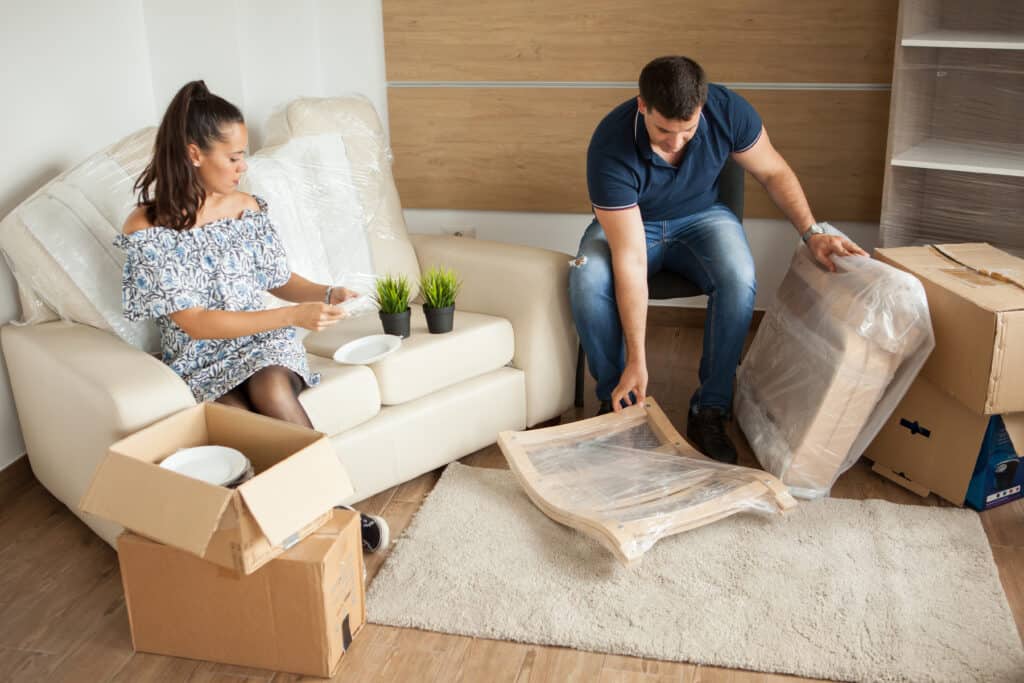- You are here:
- Home »
- Non Toxic Home Poducts »
- How to Get Rid of Formaldehyde Smell in Your Home?
How to Get Rid of Formaldehyde Smell in Your Home?
The biggest challenge people face when trying to get rid of formaldehyde is that they don’t know where it’s coming from. It can be found in various products, such as adhesives, plastics, and insulation. It can also be released into the air by burning materials that contain it.
Another challenge is that formaldehyde can be difficult to remove from the environment. It can take a lot of time and effort to rid your home of this chemical completely. And even after you’ve removed it, there is always a risk of it returning if you’re not careful.
This article will outline how to eliminate the formaldehyde smell from our homes. We will discuss the health risks associated with formaldehyde exposure, and provide tips on removing it from our environment.

What Is Formaldehyde?
Formaldehyde is a chemical found in many products we use in our homes. It can be released into the air by furniture, adhesives, insulation, and even some cleaning products.
It is used to make many products, such as particleboard, hardwood floors, and carpeting, because it makes them more durable. Formaldehyde is also used as a preservative in many industries, such as the textile industry.
The problem with formaldehyde is that it can be very harmful to our health if we are exposed to it for long periods of time. That’s why it’s important to reduce our exposure to this chemical and remove it from our homes if possible.
How to Identify Sources of Formaldehyde?
Formaldehyde can be difficult to detect because it has a very faint smell. It’s important to be aware of the signs and symptoms of formaldehyde exposure so that you can identify if this chemical is present in your home. Some of the signs and symptoms of formaldehyde exposure include:
- Headache
- Dizziness
- Fatigue
- Nausea
- Irritation of the eyes, nose, or throat
- Chest pain
- Difficulty breathing
If you are experiencing any of these symptoms, it’s important to try and determine where the formaldehyde is coming from. You can do this by checking the products in your home that may contain this chemical. Once you have identified the sources of formaldehyde in your home, you can start taking steps to get rid of it.
Inspecting our Home for Formaldehyde
The first step in getting rid of formaldehyde is to inspect your home for any sources of this chemical. It can be found in many common household products, such as adhesives, insulation, furniture, and carpeting. There are a few ways that you can inspect your home for formaldehyde:
- Check the labels of the products in your home: Many products that contain formaldehyde will have this information on the label.
- Contact the manufacturer of the product: If you’re unsure whether a product contains formaldehyde, you can contact the manufacturer and ask them.
- Use a formaldehyde test kit: You can purchase a formaldehyde test kit at most hardware stores. This will help you to identify if formaldehyde is present in your home. When inspecting your home for formaldehyde, it’s important to remember that this chemical can be found in many different places. You can place it near new furniture (for best results, put it in a drawer or inside a wardrobe) or on a new carpet to check the levels of formaldehyde it releases.
- Hire a professional to test your home: If you’re concerned about formaldehyde in your home, you can hire a professional to test the air quality.
Once you’ve identified the sources of formaldehyde in your home, you can start taking steps to remove it.
How to get rid of formaldehyde in your home?
There are a few things that you can do to get rid of formaldehyde smell from your home:
Remove the source of the formaldehyde
The best way to get rid of formaldehyde smell is to remove the source of the formaldehyde. If you have particle board furniture or synthetic carpeting, you may want to consider replacing it non toxic furniture and natural rugs and carpets.
Use an air purifier
Air purifiers can help remove formaldehyde from the air in your home and significantly improve indoor air quality.
Improve ventilation
Improving your home’s ventilation can also help remove formaldehyde from the air. Try opening windows and doors to let fresh air in or using a fan to circulate the air.
Use air-detoxifying plants
Air-detoxifying plants can also help remove formaldehyde from the air. Some of the best plants for this purpose include Boston fern, peace lily, and spider plant.
Use a dehumidifier
The EPA states that heat speeds up the formaldehyde emission rate, which could also depend on the humidity level. Dehumidifiers can help remove formaldehyde from the air by reducing the amount of moisture and keeping the indoor temperature cool.
Use activated charcoal
Activated charcoal can help to absorb formaldehyde from the air. Try placing activated charcoal in a bowl in the room where the formaldehyde smell is strongest.
Use baking soda
Baking soda can also help to absorb formaldehyde from the indoor air. Try sprinkling baking soda on surfaces where the smell is strongest. Leave it to sit for a few hours before vacuuming it up.
When using any of these methods, it’s important to remember that they may not work immediately. It may take some time for the formaldehyde levels in your home to decrease. But by taking steps to remove this chemical from your environment, you can help protect your health.

Long-term solutions to keeping formaldehyde out of our homes
There are a few things that you can do to keep formaldehyde out of your home in the long term:
Choose formaldehyde-free products
When shopping for household products, look for products that are labeled “formaldehyde-free” or “no VOCs”. Such products include paints, adhesives, flooring, cabinets, and cleaning products.
Buy solid wood furniture
Solid wood furniture is less likely to release formaldehyde into the air than particle board furniture. If it’s painted with zero-VOC paint or natural oil, it will create an even safer environment.
Avoid using harsh cleaners
Conventional cleaning products may contain VOCs, including formaldehyde. Instead, opt for natural alternatives like vinegar and baking soda or buy natural non toxic house cleaners.
Bring plants into your home
Plants are great at absorbing formaldehyde and other harmful chemicals from the air. The best air-detoxifying plants are: Spider plant, golden pothos, philodendron, and peace lily.
Use zero-VOC paint
When painting your walls, choose zero- or low-VOC paint. These paints do not release harmful chemicals into the air and are just as effective as regular paint. Try ECOS Paints or Benjamin Moore Natura Paint.
Keep your home well-ventilated
Good ventilation is key to reducing formaldehyde levels in your home. Open windows regularly to let fresh air in and help it circulate. Use an air purifier with a HEPA filter to remove toxic particles from your home.
Don’t smoke at home
Cigarette smoke is a major source of formaldehyde. If you smoke, do so outdoors to reduce the risk of exposing your family to harmful chemicals.
Regularly clean your home
Dust and dirt can accumulate on surfaces and release formaldehyde into the air when disturbed. Vacuum regularly with a HEPA filter vacuum cleaner and dust with a damp cloth.
Read More: Can Vacuuming Remove Harmful Chemicals?
Use organic and natural home textiles
Choose organic cotton, wool, and linen for your bedding, curtains, and towels. These materials are less likely to off-gas formaldehyde and other harmful chemicals. Look for Oeko-Tex-certified fabrics to be sure they are free of harmful chemicals.
Buy Non-Toxic Upholstered Furniture
When buying upholstered furniture, look for items filled with natural latex or CertiPur-certified foam. These materials are less likely to off-gas formaldehyde and other harmful chemicals.
Avoid pressed wood products
Pressed wood products (like particle board) are made with adhesives that can release formaldehyde into the air. Choose solid wood furniture instead.
Be aware of formaldehyde in building materials
If you are renovating your home, remember that some building materials (like insulation, adhesives, and flooring) can contain formaldehyde. Choose low-emitting products to reduce your exposure. Pick products with Greenguard, Floorscore, or LEED certification.
Read More: What Is FloorScore?
Store household products safely
Some household products like cleaning supplies and paint can release formaldehyde into the air. Store these products in well-ventilated areas or outside of your home to reduce the risk of exposure.
By following these tips, you can help to keep formaldehyde out of your home and create a safer, healthier environment for yourself and your family.
Wash your new clothes, bedding and other textiles
They can off-gas formaldehyde because of the way they are produced. For example, permanent press clothes are treated with formaldehyde to reduce wrinkles. To remove it, wash your new textiles before you use them.
Don’t use scented products
Scented candles, air fresheners, and other fragranced products can release formaldehyde into the air. Choose unscented products or make your own with essential oils.

What are the health risks associated with formaldehyde exposure?
Formaldehyde is associated with a variety of health problems, including:
- Respiratory problems: Formaldehyde can cause nose and throat irritation and may also worsen asthma and other respiratory conditions.
- Cancer: Formaldehyde has been classified as a human carcinogen by the International Agency for Research on Cancer. It’s been linked to nose and throat cancer and may also increase leukemia risk.
- Skin irritation: This compound may cause skin irritation and rashes when it comes into contact with the skin.
- Eye irritation: Formaldehyde can cause redness, itchiness, and tearing of the eyes.
- Headaches: Formaldehyde exposure has been linked to headaches and dizziness.
- Allergies: This chemical can trigger allergic reactions and asthma attacks in susceptible people.
If you are concerned about your exposure to formaldehyde, talk to your doctor. They can help you monitor your symptoms and advise you on how to reduce your exposure.
Read More: Best Non-Toxic Coconut Candles
FAQ
What is formaldehyde?
Formaldehyde is a colorless, flammable chemical that can become gas at room temperature. It’s one of the most common volatile organic compounds (VOCs) found in households. It’s commonly used in a variety of household products and building materials.
It’s often used as an adhesive or preservative in products like particle board, plywood, adhesives, fabrics, and cleaning supplies.
How can I be exposed to formaldehyde?
You can be exposed to formaldehyde by breathing it in, through skin contact, or by eye contact. It can also be released into the air from burning cigarettes as well as home products, such as new furniture and building materials.
What are the health effects of formaldehyde exposure in children?
Children are more susceptible to the health effects of formaldehyde exposure because they have faster breathing rates and their bodies are still developing. Formaldehyde exposure has been linked to respiratory problems, cancer, skin irritation, and allergies in children.
What neutralizes formaldehyde smell?
Activated charcoal is one of the best materials for absorbing formaldehyde from the air. It can be placed in a bowl or container and left in the room to absorb formaldehyde molecules from the air. You can also try placing bowls of vinegar or baking soda around the room to help neutralize the smell.
Do air purifiers work for formaldehyde?
Air purifiers can help to remove formaldehyde from the air. Look for an air purifier with a HEPA filter, as these are the most effective at trapping formaldehyde and other VOCs. Activated carbon filters can also be effective at reducing formaldehyde levels in the indoor air.
Conclusion: Keeping Your Indoor Air Formaldehyde-Free
Formaldehyde is a dangerous chemical that can cause health problems in people who are exposed to it. It’s important to get rid of any formaldehyde in our homes, as it can be harmful to our health. In this article, we have outlined how to get rid of the formaldehyde smell from our homes.
We have discussed the health risks associated with exposure to this chemical and provided tips on how to remove it from our environment. We hope that this information will be helpful to you in getting rid of formaldehyde in your home. Thanks for reading!
About the Author Kamila Flieger
My name is Kamila, and I'm passionate about researching non-toxic, organic products for the home. I believe it's so important to create a safe and healthy environment for our families, and I enjoy helping others do the same.


